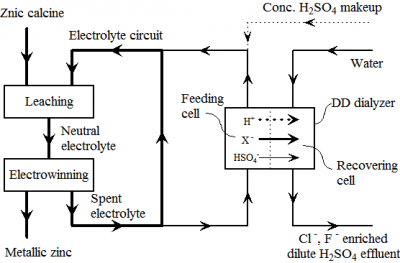Selective removal of halides from spent zinc sulfate electrolyte by diffusion dialysis
J. Membr. Sci. 2017, 537, Pages 111–118 (1 September 2017)
By Hui-Fang Xiao, Qing Chen, Huan Cheng, Xiu-Min Li, Wen-Meng Qin, Bao-Sheng Chen, Dong Xiao, Wei-Ming Zhang*
j.memsci.2017.05.009, fulltext mmc1.xlsx
Zinc metal is mainly produced by a hydrometallurgical process, in which zinc electrolyte is recirculated, and impurities especially halides are accumulated then, which have dreadful impacts on the process and product. Until now numerous efforts have been made to remove halides from the electrolyte, but none of them are fully satisfying, and it is still a big issue for the industry. As a conventional membrane technology, diffusion dialysis (DD) is originally designed to recover free acid from acid-salt mixture by concentration gradient. In this work, we proposed a novel process to selectively remove these halide impurities from the spent zinc electrolyte by DD directly. Significant Cl- and F- permselectivities over HSO4- are observed in this process. The removal efficiencies are as high as 50–70% and 30–42% for chloride and fluoride, respectively, while the zinc loss is less than 1%. The flow intensity in the current work is much higher than that in conventional DD, which reduces the overall cost immensely. The mechanism of this selective mass transfer is also studied intensively to understand influence of flow intensity, charge number and hydrated radii of ions on the permselectivity. The results here are not confined to provide a superior method to remove halide impurities for the zinc industry, but also extend new applications and deepen understandings for the well-established DD process in selective ion separation. This capability is very likely to become a new growth point and future direction for the DD process besides acid/alkali recovery.
